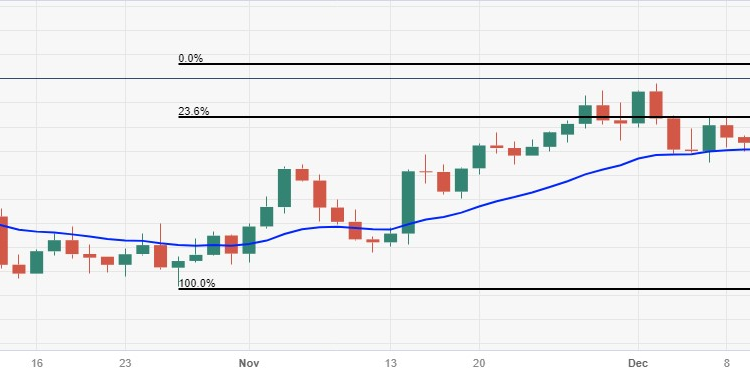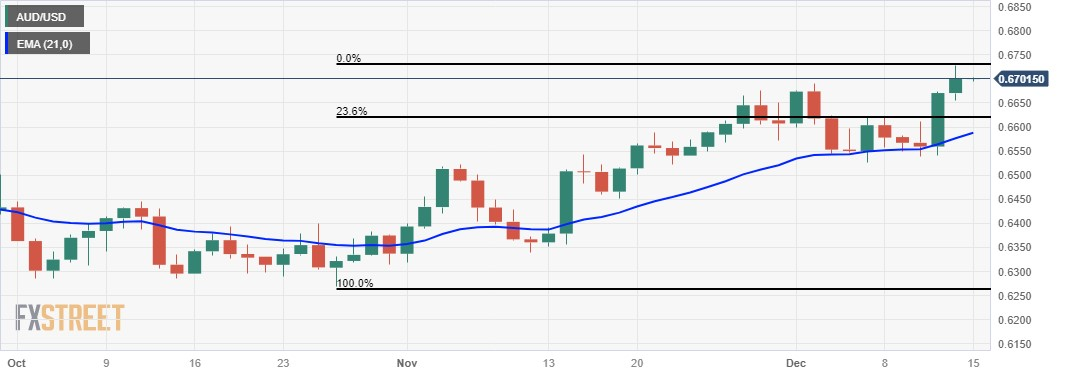Australian Dollar stretches higher on improved Australian, Chinese data
- Australian Dollar maintains bullish sentiment on dovish Fed outlook.
- Australia’s Manufacturing and Services PMI increased to 47.8 and 47.6, respectively.
- PBoC maintained its Medium-term Lending Facility rate (MLF) at 2.5%.
- China's Industrial Production and Retail Sales improved to 6.6% and 10.1%, respectively, in November.
- US Retail Sales rose 0.3% and Initial Jobless Claims reduced to 202K.
The Australian Dollar (AUD) continues its winning streak for the third consecutive day on Friday. The AUD/USD pair receives upward support from improving Australia’s Purchasing Managers Index (PMI) data for December, released by Judo Bank and S&P Global. Additionally, China's improved data contributes support to reinforcing the strength of the Australian Dollar.
Australia's economy displays resilience, bolstered by robust employment results and expanding incomes. The preliminary Judo Bank Composite PMI has shown improvement, rising to 47.4 from the previous reading of 46.2. The Manufacturing PMI for the same period registered 47.8, a slight increase from the prior figure of 47.7. Additionally, the Services PMI grew to 47.6 compared to the previous reading of 46.0.
The People's Bank of China (PBoC) kept its 1-year Medium-term Lending Facility (MLF) rate unchanged at 2.5%, the interest rate on MLF loans is a key factor influencing liquidity conditions in the banking system. Additionally, 650 billion Yuan worth of MLF loans are set to mature, and the central bank injects 1.45 trillion Yuan, a greater amount to bolster bank liquidity. These actions by the PBoC support the financial system and enhance economic conditions in China. Given Australia's status as a major exporter to China, improvements in China's economic conditions often translate to increased demand for Australian exports, contributing to the strength of the Aussie Dollar.
The National Bureau of Statistics of China revealed that Industrial Production (YoY) improved to 6.6% in November from 4.6% prior, exceeding the market expectation of 5.6%. However, China Retail Sales (YoY) rose to 10.1% from 7.6% prior, falling short of the market consensus of a 12.5% rise.
The US Dollar Index (DXY) attempts to rebound from a four-month low at 101.77 marked on Thursday. The DXY extends the negative momentum that followed the Federal Open Market Committee (FOMC) statement. Better-than-expected economic data from the United States (US) provided only modest support for the US Dollar (USD).
US Retail Sales (MoM) rose 0.3% in November, compared to the expected decline of 0.1%. Initial Jobless Claims for the week ending on December 8 came in at 202K against the 220K expected.
The dovish signals from the US Federal Reserve (Fed) have put pressure on the USD, especially as Treasury yields dropped to multi-month lows. The Fed's cautious outlook on interest rates and the potential for a more accommodative monetary policy stance in 2024 contribute to the ongoing weakness in the Greenback.
Daily Digest Market Movers: Australian Dollar soars on dovish Fed’s outlook
- Australia’s Consumer Inflation Expectations for December eased at 4.5% against the previous figures of 4.9%.
- The seasonally adjusted Employment Change (Nov) improved substantially to 61.5K compared to the expected 11.0K. Unemployment Rate rose to 3.9% from 3.7% previously.
- ANZ-Roy Morgan Australian Consumer Confidence weekly survey rose to 80.8 from the previous week's 76.4.
- Westpac Consumer Confidence for December showed improvement at 2.7% from the previous decline of 2.6%.
- Australian government anticipates a significantly improved budget bottom line this year as revenues outpace forecasts. In the mid-year economic and fiscal outlook (MYEFO) presented by Labor Treasurer Jim Chalmers, a budget deficit of just AUD 1.1 billion (USD 721.4 million) in the year to end June 2024 is projected, down from the AUD 13.9 billion forecast back in May.
- Federal Reserve (Fed) maintained interest rates at 5.5% in its December policy meeting as expected. Markets are now projecting three rate cuts for 2024.
- US Bureau of Labor Statistics revealed that the PPI (YoY) reduced to the growth of 0.9% against the expected growth of 1.0%, while the Core PPI came in at 2.0% against the 2.2% expected.
- US Bureau of Labor Statistics revealed that the US Consumer Price Index (CPI) for November rose by 0.1% month-on-month and 3.1% year-on-year. Both figures aligned with market consensus, indicating that inflation levels met expectations.
- US Core CPI, which excludes volatile food and energy prices, climbed by 0.3% MoM and 4.0% YoY, in line with expectations.
Technical Analysis: Australian Dollar hovers around the 0.6700 psychological level
The Australian Dollar hovers around the psychological level of 0.6700 on Friday after pulling back from a five-month low at 0.6728 recorded in the previous session. A bullish sentiment could drive the AUD/USD pair to revisit the recent high, followed by the significant barrier at 0.6750. On the downside, the key support at 0.6650 is of significance followed by the 23.6% Fibonacci retracement at 0.6619, before reaching the psychological support at 0.6600. A decisive breach below this support level might exert downward pressure on the AUD/USD pair to test the 21-day Exponential Moving Average (EMA) at 0.6588.
AUD/USD: Daily Chart
Australian Dollar price today
The table below shows the percentage change of Australian Dollar (AUD) against listed major currencies today. Australian Dollar was the strongest against the Pound Sterling.
| USD | EUR | GBP | CAD | AUD | JPY | NZD | CHF | |
| USD | -0.04% | 0.05% | -0.14% | -0.22% | -0.20% | -0.13% | -0.08% | |
| EUR | 0.01% | 0.06% | -0.11% | -0.21% | -0.15% | -0.15% | -0.05% | |
| GBP | -0.03% | -0.05% | -0.16% | -0.25% | -0.22% | -0.19% | -0.10% | |
| CAD | 0.13% | 0.06% | 0.16% | -0.09% | -0.06% | -0.02% | 0.06% | |
| AUD | 0.22% | 0.21% | 0.27% | 0.10% | 0.05% | 0.06% | 0.16% | |
| JPY | 0.21% | 0.16% | 0.22% | 0.08% | 0.00% | 0.00% | 0.12% | |
| NZD | 0.18% | 0.09% | 0.15% | -0.02% | -0.10% | -0.11% | 0.11% | |
| CHF | 0.07% | 0.05% | 0.11% | -0.06% | -0.15% | -0.12% | -0.08% |
The heat map shows percentage changes of major currencies against each other. The base currency is picked from the left column, while the quote currency is picked from the top row. For example, if you pick the Euro from the left column and move along the horizontal line to the Japanese Yen, the percentage change displayed in the box will represent EUR (base)/JPY (quote).
RBA FAQs
The Reserve Bank of Australia (RBA) sets interest rates and manages monetary policy for Australia. Decisions are made by a board of governors at 11 meetings a year and ad hoc emergency meetings as required. The RBA’s primary mandate is to maintain price stability, which means an inflation rate of 2-3%, but also “..to contribute to the stability of the currency, full employment, and the economic prosperity and welfare of the Australian people.” Its main tool for achieving this is by raising or lowering interest rates. Relatively high interest rates will strengthen the Australian Dollar (AUD) and vice versa. Other RBA tools include quantitative easing and tightening.
While inflation had always traditionally been thought of as a negative factor for currencies since it lowers the value of money in general, the opposite has actually been the case in modern times with the relaxation of cross-border capital controls. Moderately higher inflation now tends to lead central banks to put up their interest rates, which in turn has the effect of attracting more capital inflows from global investors seeking a lucrative place to keep their money. This increases demand for the local currency, which in the case of Australia is the Aussie Dollar.
Macroeconomic data gauges the health of an economy and can have an impact on the value of its currency. Investors prefer to invest their capital in economies that are safe and growing rather than precarious and shrinking. Greater capital inflows increase the aggregate demand and value of the domestic currency. Classic indicators, such as GDP, Manufacturing and Services PMIs, employment, and consumer sentiment surveys can influence AUD. A strong economy may encourage the Reserve Bank of Australia to put up interest rates, also supporting AUD.
Quantitative Easing (QE) is a tool used in extreme situations when lowering interest rates is not enough to restore the flow of credit in the economy. QE is the process by which the Reserve Bank of Australia (RBA) prints Australian Dollars (AUD) for the purpose of buying assets – usually government or corporate bonds – from financial institutions, thereby providing them with much-needed liquidity. QE usually results in a weaker AUD.
Quantitative tightening (QT) is the reverse of QE. It is undertaken after QE when an economic recovery is underway and inflation starts rising. Whilst in QE the Reserve Bank of Australia (RBA) purchases government and corporate bonds from financial institutions to provide them with liquidity, in QT the RBA stops buying more assets, and stops reinvesting the principal maturing on the bonds it already holds. It would be positive (or bullish) for the Australian Dollar.



Comments are closed.